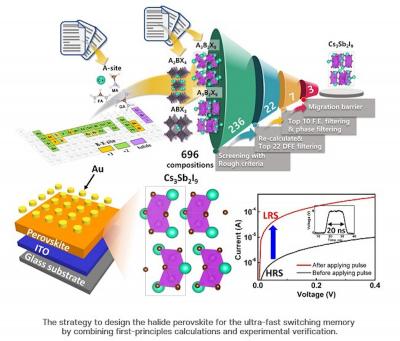A research team led by Professor Jang-Sik Lee of Pohang University of Science and Technology (POSTECH) has developed a halide perovskite-based memory with ultra-fast switching speed.

Resistive switching memory is a promising contender for next-generation memory device due to its advantages of simple structure and low power consumption. Various materials have been previously studied for resistive switching memory. Among them, halide perovskites are receiving much attention for use in the memory because of low operation voltage and high on/off ratio. However, halide perovskite-based memory devices have limitations like slow switching speed which hinder their practical application in memory devices.
From a total of 696 compounds of halide perovskites candidates, Cs3Sb2I9 with a dimer structure was selected as the best candidate for memory application. To verify the calculation results, memory devices using the dimer-structured Cs3Sb2I9 were fabricated. They were then operated with an ultra-fast switching speed of 20 ns, which was more than 100 times faster than the memory devices that used the layer-structured Cs3Sb2I9 . In addition, many of the perovskites contain lead (Pb) in the materials which has been raised as an issue. In this work, however, the use of lead-free perovskite eliminates such environmental problems.
'This study provides an important step toward the development of resistive switching memory that can be operated at an ultra-fast switching speed,' said Professor Lee on the significance of the research. He added that 'this work offers an opportunity to design new materials for memory devices based on calculations and experimental verification.'



